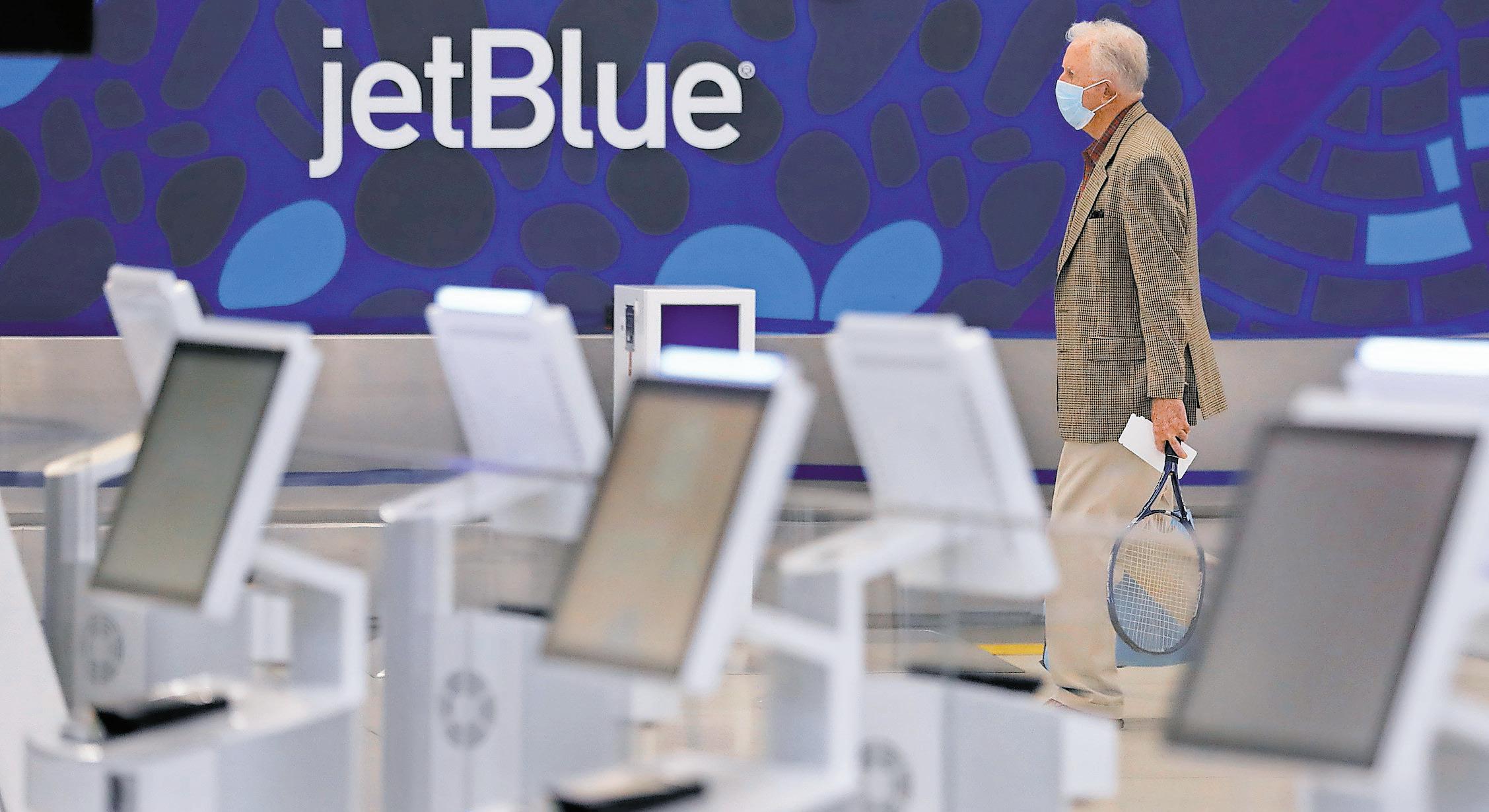
17 minute read
Jetblue goes hostile on sPirit
Rebuffed by Spirit, JetBlue goes hostile in takeover bid
Carrier now asking Spirit shareholders to reject Frontier Airlines proposal
Michelle Chapman David Koenig, The Associated Press
JetBlue is going hostile in its bid for Spirit Airlines and asking shareholders of the low-cost carrier to reject a proposed acquisition by Frontier Airlines. JetBlue, in going straight to shareholders with its offer, wants to push Spirit’s board to the negotiating table. On Monday, shares of Spirit, based in Miramar, Florida, jumped 12% in midday trading. JetBlue pitched a new offer of $30 per share in cash, or more than $3.2 billion, to Spirit stockholders but said its April 5 offer of $33 per share is still available if Spirit enters negotiations. Spirit’s board rejected JetBlue’s original $3.6 billion bid on May 2, saying antitrust regulators are unlikely to approve an offer from the New York City airline largely because of its alliance with American Airlines in the Northeast. The Justice Department is suing to block that deal.
Shareholders of Spirit Airlines Inc. are scheduled to vote June 10 on the Frontier bid, which is favored unanimously by the Spirit board. The cash-and-stock offer was valued at $2.9 billion when announced in February, but Frontier’s shares have dropped 30% since, reducing the value of the deal. JetBlue said its new offer is lower because of Spirit’s unwillingness to share financial information that JetBlue requested. “The Spirit Board failed to provide us the necessary diligence information it had provided Frontier and then summarily rejected our proposal, which addressed its regulatory concerns, without asking us even a single
question about it,” JetBlue CEO Robin Hayes wrote in a letter. “The Spirit Board based its rejection on unsupportable claims that are easily refuted.” Hayes said JetBlue is offering a significant premium in cash, more certainty, and more benefits for all Spirit investors. He said JetBlue is confident of winning regulatory approval, and called the Frontier bid high risk and low value. Neither Spirit nor Frontier responded immediately to requests for comment. The bid from Frontier Group Holdings Inc. provides less cash but would let Spirit shareholders keep 48.5% of the combined airline. It would give Spirit shareholders 1.9126 shares of Frontier plus $2.13 in cash for each Spirit share. Either combination involving Spirit would create The Spirit Board failed to the nation’s fifth-biggest airline behind American, provide us the necessary Delta, United and Southwest. Frontier and Spirit are similar airlines that offer diligence information it had provided Frontier and low fares and get more revenue from tacking on fees for many things. JetBlue is more like the big airlines it hopes to catch. It generally charges then summarily rejected our higher fares than the discount airlines, but it provides more space between rows and adds proposal. amenities, including free TV. Robin Hayes CEO, JetBlue Shares of JetBlue Airways Corp. fell 4% while shares of Frontier, based in Denver, climbed more than 6% in midday trading Monday.
In fact,
opinion
Gustavo Vélez
Economist
A new era of economic development for Puerto Rico
Given the intense public debate surrounding tax incentives as a desirable mechanism to advance the economic development of Puerto Rico, it is worth reviewing the economic history of the island to put in a fair perspective not only the role they have played in the past but the economic future to which we can aspire.
By the 1940s, Puerto Rico was going through difficult economic times. The devastating impact of hurricanes and the effects of the Great Depression were just some of the economic challenges facing the island. In response, the local leadership formulated Operation Bootstrap (“Manos a la Obra”), which was conceptualized as a project aimed at economic transformation through industrialization and external investment, promoting the export of locally finished products.
As part of that project, the Government of Puerto
Rico approved for the first time an industrial incentives’ law that allowed for a ten-year exemption from income and property taxes applicable to the establishment of new industries, the expansion of existing production operations and the construction of hotel facilities. This exemption also included taxes on the acquisition of machinery and raw materials, and went hand in hand with a federal tax exemption for corporations that invested on the island.
“Manos a la Obra” caused accelerated economic growth that led to the creation of thousands of jobs and the establishment of hundreds of factories from all kinds of industrial sectors. Although looking back, the decision to not include agriculture as part of the economic push may now seem questionable, it is undeniable that “Manos a la Obra” achieved an economic transformation with dramatic results that quickly caught the attention of the rest of the world. To illustrate, by 1949, the U.S. Department of Commerce estimated that nearly 2,000 manufacturing establishments on the island employed some 55,000 Puerto Ricans. By 1967, that number rose to more than 120,000.
In the mid-70s, a review of the tax system in the United States included the creation of Section 936 of the federal internal revenue code, which granted companies established on the Island a tax credit against their federal tax obligation equivalent to the income generated by commercial activities or businesses carried out on or from the island.
As a tool to advance economic growth, Section 936 yielded benefits for the Island and that gave continuity to the industrialization project of Puerto Rico, promoted the local injection of capital, the transfer of technology and knowledge, as well as the creation of increasingly better paid jobs in the industrial and professional services sectors.
We now face a new set of economic challenges, including maintaining economic growth after the debt restructuring process. Puerto Rico has a new tool that can open the door to a new economic transformation that leads to growth and stability, this time in a diversified and balanced way, incorporating sectors such as technology, services, finance, tourism, real estate, and agriculture itself.
Act 60 of 2019, which was approved by the local government in 2019, goes beyond previous local legislation in the area of incentives. Its purpose is to consolidate all existing tax benefits into a single code, eliminating all incentives deemed obsolete or that had little or no real and effective contribution to Puerto Rico’s economy. Before Law 60, there were approximately 76 different laws and programs, created between 1945 and 2019, that comprised the legal framework of Puerto Rico’s economic incentives.
Investments by individuals designated as resident investors under Act 60 (previously Act 22) in real estate and businesses on the island are presently estimated at over $4 billion and growing, according to the Performance of Incentive Programs report prepared by economic research firm Estudios Técnicos and commissioned by the DEDC in 2019. Planned capital investments were estimated at $678 million and the number of direct jobs created at over 4,400. The incentives in the new code, available to local entrepreneurs, Puerto Rican professionals and investors, open the door to the return of professional and business talent to our island to create new startups or join existing companies. That process is already underway.
We have the opportunity to correct past mistakes and catapult our island into a new era of economic growth, building on our capabilities, knowledge, human resources, our culture, relationship with the United States and a privileged geographical location that unites the hemisphere.
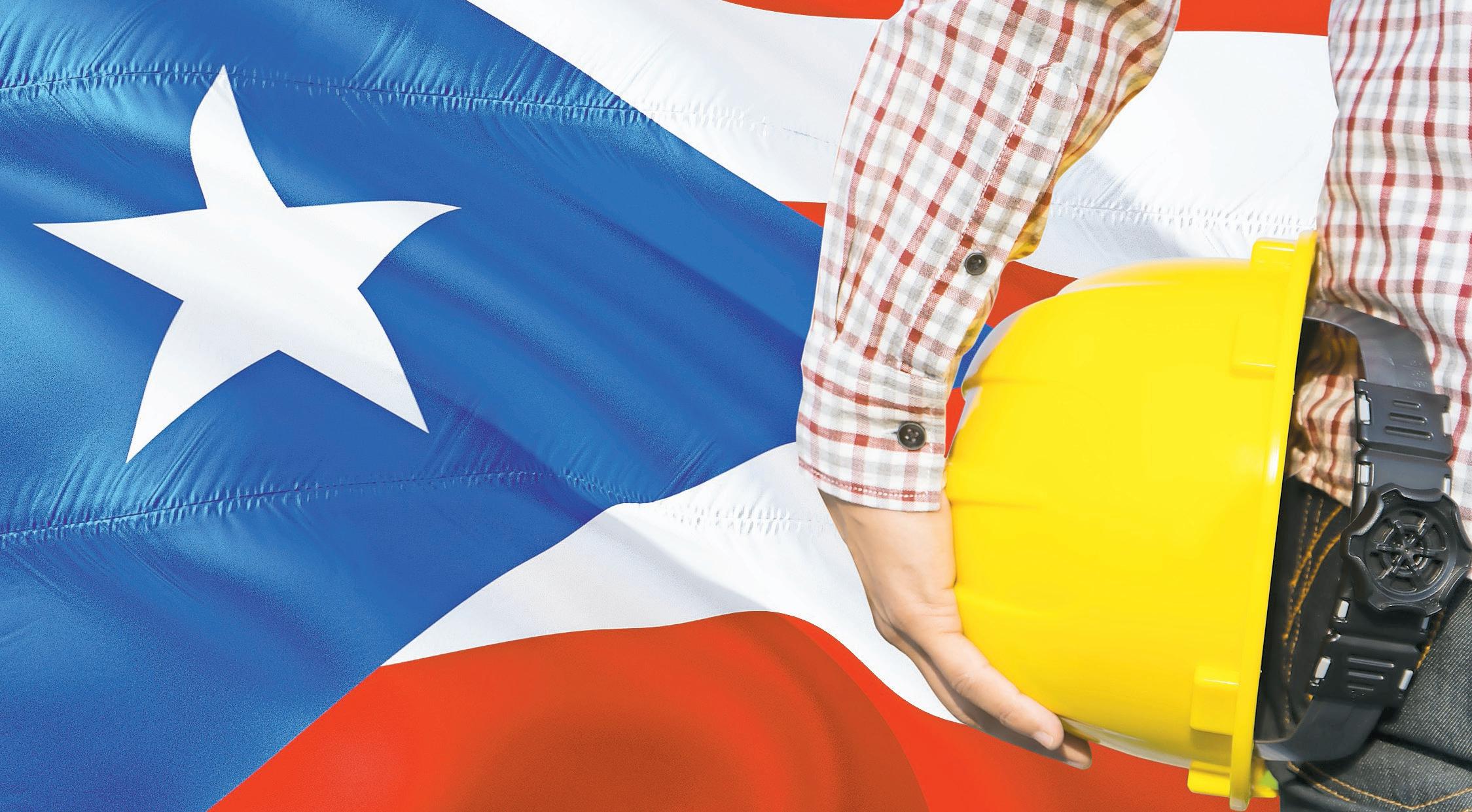
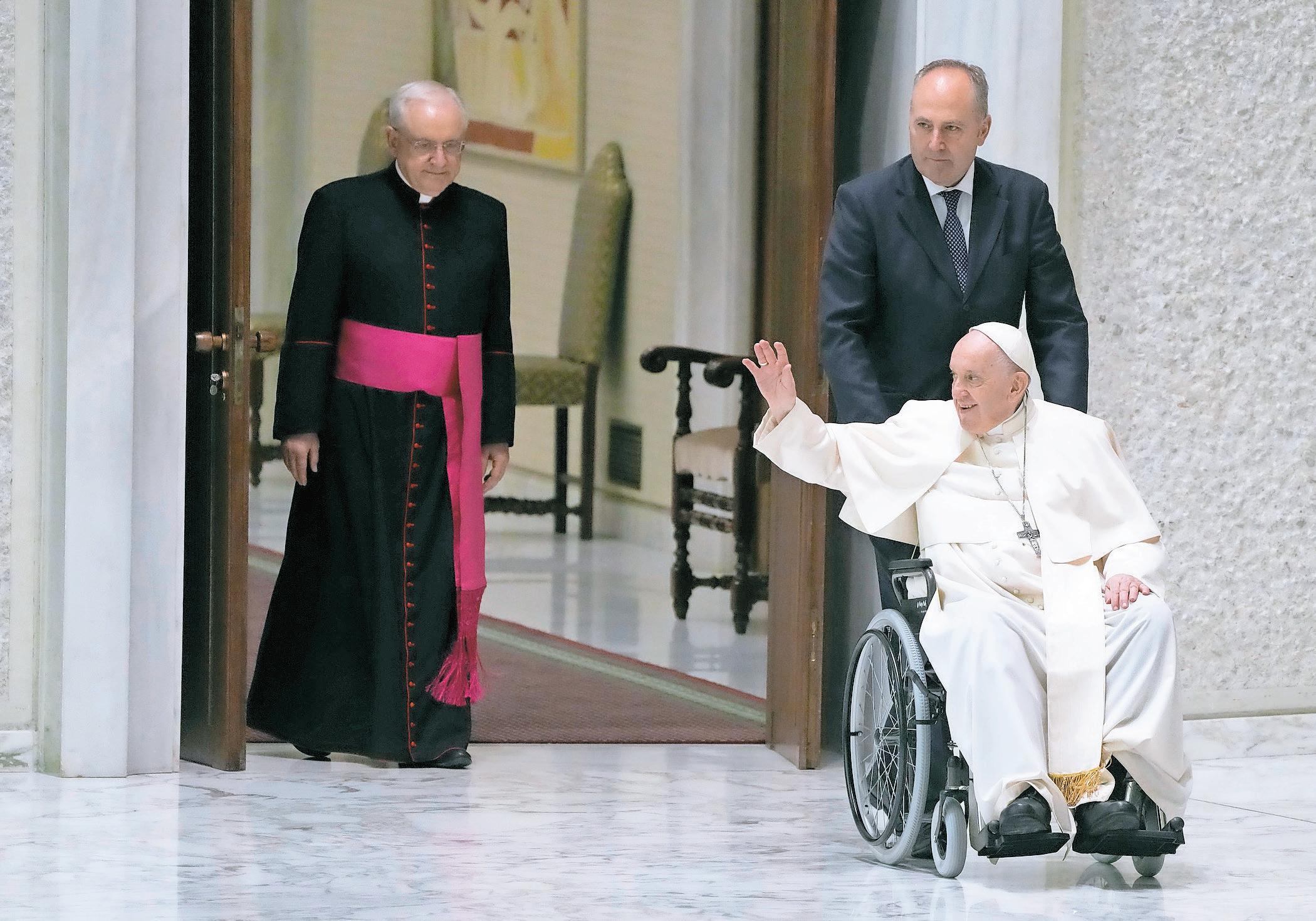
Pope Francis arrives in a wheelchair in the Paul VI hall to attend an audience with pilgrims from central Italy at the Vatican. >AP Photo/Gregorio Borgia
Pope’s recipe to heal his painful knee? A shot of tequila
Nicole Winfield, The Associated Press
ROME (AP) — Doctors have prescribed a wheelchair, cane and physical therapy to help heal Pope Francis’ bad knee. He has other ideas.
According to a viral video of the pope at the end of a recent audience, Francis quipped that what he really needs for the pain is a shot of tequila.
Francis was riding in the popemobile in St. Peter’s Square when he stopped near a group of Mexican seminarians from the Legion of Christ, who asked him in his native Spanish how his knee was doing. After he replied that it was “capricious,” they told Francis that they admired his ability to smile despite the pain, and that he was an example for future priests like themselves.
“Do you know what I need for my knee?” Francis asked them from the popemobile. “Some tequila.” The seminarians laughed and promised to deliver a bottle to the Santa Marta hotel where Francis lives.
The 85-year-old Argentine pope has been suffering from strained ligaments in his right knee for months, and on doctors’ orders, recently has been using a wheelchair and a cane to get around, so he can let it heal.
The limits on his mobility have spurred a predictable round of media speculation about his health and a future conclave, but a close collaborator recently said the pope is “better than ever” and is undergoing two hours of physiotherapy a day.
“He’s in very good health and the same lucid reflection as always,” La Plata, Argentina Bishop Víctor Manuel Fernández tweeted May 14 after seeing the pope. “(There’s) a problem in one of his knees, but every day he has more than two hours of rehabilitation, which is producing results. For everything else, he’s better than ever.”
Francis recently pulled out of a planned two-day trip to Lebanon next month, citing the knee problem, but the Vatican has confirmed he will travel to Congo and South Sudan, as well as Canada, in July.
The Pope’s convalescence coincides with the Vatican’s foreign minister, Archbishop Paul Gallagher, visit to Kyiv this week as the Holy See seeks to balance its concern for Ukrainians amid Russia’s war with its efforts to keep open a channel of dialogue with Moscow. The Vatican said Gallagher would stop first in Lviv to meet with refugees and regional officials, and then move onto Kyiv for the meeting with Kuleba and to tour the destruction nearby. The secretariat of state tweeted Tuesday that the visit would mark the 30th anniversary of diplomatic relations with Ukraine and show the closeness of the pope and Holy See to Ukraine, “reaffirming the importance of dialogue to reestablish peace.” The trip comes as the Holy See toes a delicate line in trying to keep alive newly improved ties with the Russian Orthodox Church while offering support to the “martyred” Ukrainian faithful. At the same time, the Holy See is reconciling Pope Francis’ frequent denunciation of the weapons industry and “crazy” recourse to rearming Ukraine with Catholic teaching that says states have a right and duty to repel an “unjust aggressor.”
In fact,
Renovated NYC museum hall showcases Indigenous perspectives
The collection is infused with 21st century sensibilities
Deepti Hajela, The Associated Press
what it should look like for the showcase of 10 Pacific Northwest tribal nations. The hall includes some iconic pieces that anyone who has been to the museum will remember - including a massive 63-foot-long canoe that for decades was placed outside the hall but has now been brought in and suspended from the ceiling, as well as several giant carvings. But its new exhibit, items are accompanied by text in both English and Indigenous languages and includes a gallery section showing how younger Indigenous artists are using motifs and designs from prior generations. There was also, and continues to be, the fundamental question of whether museums should be holding these collections and trying to tell these stories in the first place, given the role that theft and colonization has played in building them, and the way Indigenous communities have been treated. Museums “seem to function as very expensive, and in the case of the American Museum of Natural History, maybe the most expensive, trophy cases in the world,” said Haa’yuups, cocurator of the hall, who is Head of the House of Takiishtakamlthat-ḥ, of the Huupa‘chesat-ḥ First Nation. He saw his involvement as a way to help spur a difference, to get people thinking about whether the items on display would be better served by being with the people they came from. “Does it make sense to have a bunch of people
NEW YORK — In his first visit to the American Museum of Natural History, Morgan Guerin had a list. Not of things he wanted to check out, though — a list of things that he hated. It started with seeing certain regalia from his Musqueam Indian Band — sacred objects not intended for public display — in the museum’s Northwest Coast Hall. This wasn’t just any visit. Guerin was there at the museum’s invitation in 2017 for the start of a project to renovate the hall, incorporating Indigenous perspectives. For him and representatives of other Indigenous communities in the Pacific Northwest and western Canada, the 5-year, $19-million renovation of the Northwest Coast Hall, which reopened to the public Friday, was an opportunity to tell their stories themselves. “Our people are very, very tired of being ‘studied,’ because the misconception of who we are has always been the outside community’s downfall,” he said. In fact, “We have always been here, ready to tell people who we are.” The hall was the museum’s first gallery, opened in 1899 under the auspices of Franz Boas, an anthropologist who was deeply interested in the Indigenous cultures of the Northwest and western coastal The hall was the museum’s first gallery, opened in 1899 under the auspices of Franz Boas, an anthropologist. who have nothing to do with objects, to have them spend their lives managing them?” he said. “Or does it make sense to send those treasures back to the communities where they come from?” Canada. Boas was also a It’s an issue the museum has and is continuing proponent of what was then a to grapple with, said Peter Whiteley, curator of revolutionary idea that different North American ethnology. He said the institution, cultures should be looked at in their own right and which has repatriated items over the years, had not on some kind of comparative scale. decided through the renovation process that it was It had largely remained unchanged, though, willing to do some additional limited repatriation since the early 1900s. When museum officials and develop greater collaboration between the decided it was time to renovate, they knew they museum and the native tribes. couldn’t do it without input from the people whose Deeper questions notwithstanding, those who cultures are on display. took part in the process, both from the Indigenous “A lot of what we did was trying to bring this nations and the museum staff, said it was a historic collection to the 21st century, and that’s by valuable one in terms of showing what is possible telling new stories with active voices in all of these regarding collaboration and listening to Indigenous communities and nations,” said Lauri Halderman, voices. vice president for the exhibition. “The best thing about this, the result of these The museum brought together the consultants from the different native tribes,” said representatives of the Indigenous communities David Boxley, representing the Tsimshian tribe, “is to talk about what the gallery should contain and that it’s our voice speaking.”
Artifacts, dioramas, and representations of Native American culture from the northwest coast of North America are displayed, at the American Museum of Natural History in New York. >AP Photo/John Minchillo
A lot of what we did was trying to bring this historic collection to the 21st century, and that’s by telling new stories with active voices in all of these communities and nations.
Lauri Halderman VP for the exhibition
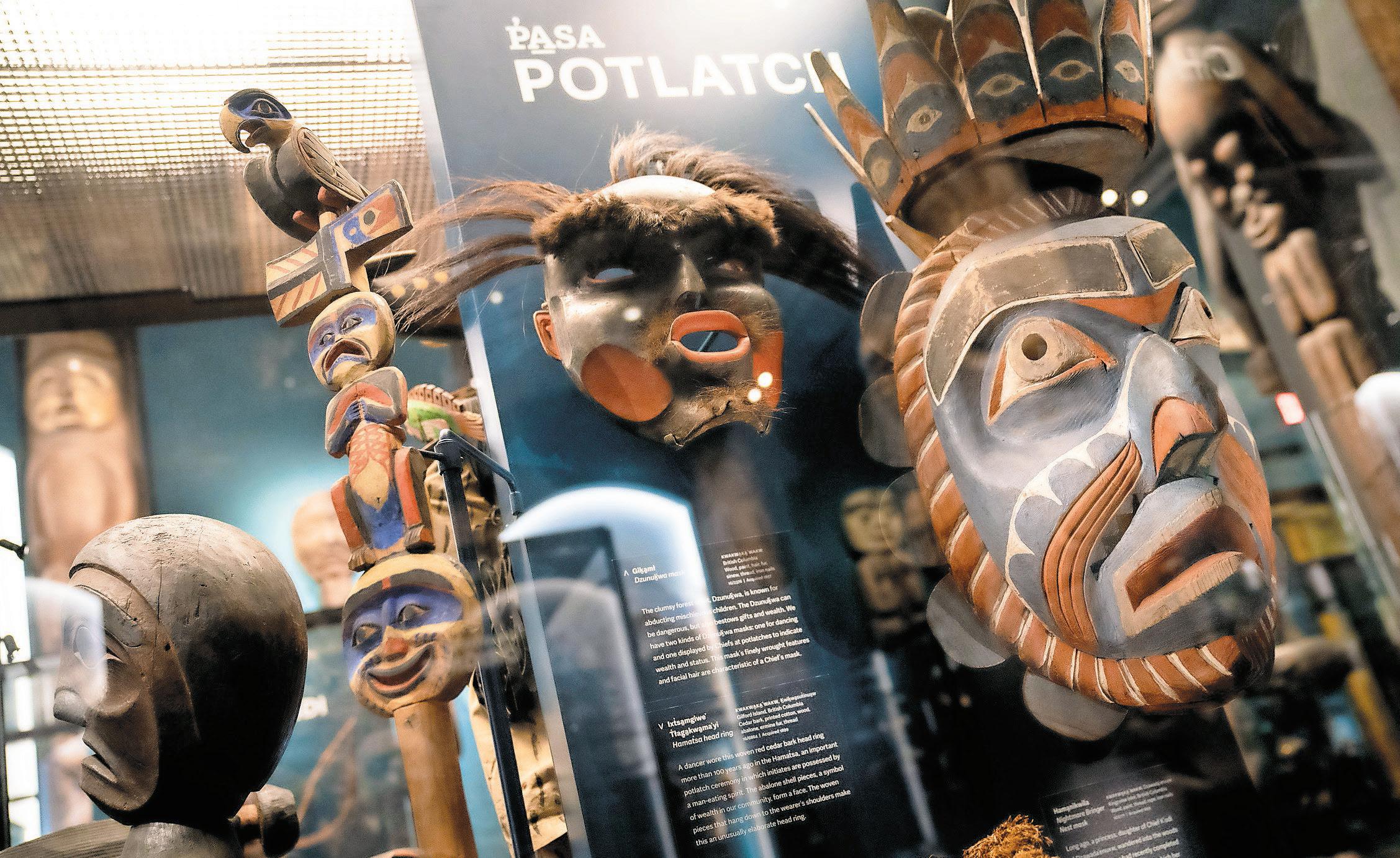
Zelenskyy opens Cannes Film Festival
Links war and cinema
Jake Coyle, The Associated Press
CANNES, France — The 75th Cannes Film Festival kicked off Tuesday with an eye turned to Russia’s war in Ukraine and a live satellite video address from Ukrainian President Volodymyr Zelenskyy, who called on a new generation of filmmakers to confront dictators as Charlie Chaplin satirized Adolf Hitler.
After tributes and musical numbers, Zelenskyy was streamed live for the formally attired audience who had gathered for the premiere of Michel Hazanavicius’ zombie comedy “Final Cut.”
Zelenskyy, dressed in his signature olive green shirt, drew a thunderous standing ovation and spoke at length about the connection between cinema and reality. He referenced films like Francis Ford Coppola’s “Apocalypse Now” and Charlie Chaplin’s “The Great Dictator” as not unlike Ukraine’s present circumstances. Zelenskyy quoted Chaplin’s final speech in “The Great Dictator,” which was released in 1940, in the early days of World War II: “The hate of men will pass, and dictators die, and the power they took from the people will return to the people.”
“We need a new Chaplin who will demonstrate that the cinema of our time is not silent,” implored Zelenskyy. The Ukrainian president pushed filmmakers not to “stay silent” while hundreds continue to die in Ukraine, the largest war in Europe since WWII, and show that cinema “is always on the side of freedom.”
Ukrainian President Volodymyr Zelenskyy.
The war is to be a regular presence in Cannes, where the festival has barred Russians with ties to the government from attending this year. Set to screen are several films from prominent Ukrainian filmmakers, including Sergei Loznitsa’s documentary “The Natural History of Destruction.” Footage shot by Lithuanian filmmaker Mantas Kvedaravičius before he was killed in Mariupol in April will also be shown by his fiancée, Hanna Bilobrova. Even “Final Cut,” the latest film from “The Artist” filmmaker Hazanavicius, was renamed from its
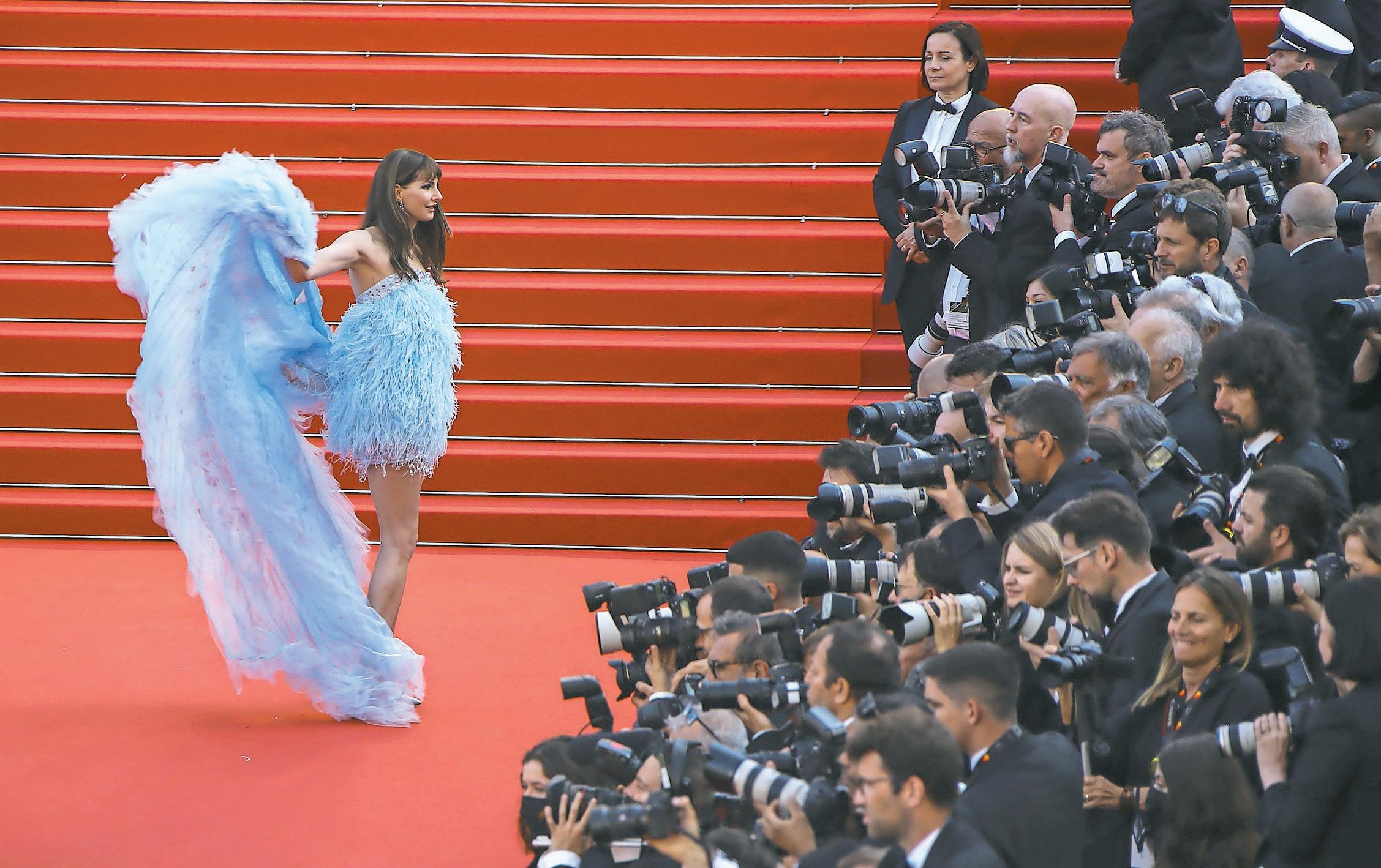
French model and actress Frederique Bel poses for photographers upon arrival at the opening ceremony and the premiere of the film ‘Final Cut’ at the 75th Cannes Film Festival. >AP Photo/Dionisia Vasilopoulou
original title, “Z,” after Ukrainian protesters noted that the letter Z to some symbolizes support for Russia’s war in Ukraine. Formally attired stars including Eva Longoria, Julianne Moore, Bérénice Bejo and “No Time to Die” star Lashana Lynch were among those who streamed down Cannes’ famous red carpet Tuesday. More starstudded premieres — “Top Gun: Maverick!” “Elvis!” — await over the next 12 days, during which 21 films will vie for the festival’s prestigious top award, the Palme d’Or.
But Tuesday’s opening and the carefully choreographed red-carpet parade leading up the steps to the Grand
Théâtre Lumiére again restored one of the movies’ grandest pageants after two years of pandemic that have challenged the exalted stature Cannes annually showers on cinema.
“Dear friends, let’s come out of this dark together,” said opening ceremony host Virginie Efira.
After last year requiring regular COVID-19 testing and masks in theaters — and no kisses on the red carpet — Cannes has largely done away with pandemic protocols. Masks are recommended inside, but are rarely worn.
Cannes presented an honorary Palme d’Or to Forest Whitaker, who received a standing ovation. Whitaker, who won best actor at Cannes 34 years ago for his performance as Charlie Parker in Clint Eastwood’s “Bird,” said that while ascending the steps to the Palais des Festivals on Tuesday, he could still hear chants of “Clint! Clint!” ringing in his ears. Eastwood is one of few others who have been awarded an honorary Palme. On Tuesday, Cannes also
In fact, unveiled the jury that will award the Palme d’Or. French actor Vincent Lindon is leading a jury that includes Deepika The festival is Padukone, Rebecca Hall, hosting TikTok Asghar Farhadi, Trinca, Ladj Ly, creators from Noomi Rapace, Jeff Nichols and around the world Joachim Trier. and holding a At the tradition-upholding separate contest Cannes, the world’s largest for best (very short) and most glitzy temple to videos created film, cinema, controversy and during the festival. glamour swirl together in a 12-day spectacle of red carpet premieres and rampant movie deal-making up and down the Croisette. Theatrical release is a requirement of any film vying for the Palme, which has prevented streaming services from playing a big role at Cannes. But this year, one new festival partner — TikTok — has raised some eyebrows. The festival is hosting TikTok creators from around the world and holding a separate contest for best (very short) videos created during the festival. Thierry Fremaux, artistic director of Cannes, granted TikTok wasn’t the future of cinema. “The cinema remains the final art,” said Fremaux.




